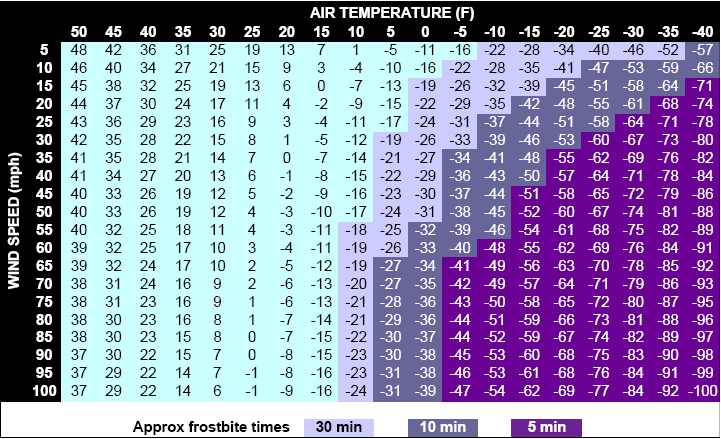
Accumulating lake effect snow will increase in intensity later today and continue through Wednesday. Read More >
Gaylord, MI
Weather Forecast Office
|
|
|
|
|
|
 |
Winter Hazards Awareness Week
|
 |
|
Day 6 - How Snow and Cold May Affect Your Health |
|
|
The wind chill index is one tool that can help with decision making during the winter season. The National Weather Service wind chill index draws on the latest research in meteorology and human bio-mechanics. For example, at an actual air temperature of 15 degrees, the effect of a 15 mph wind would be to make exposed skin react as if the temperature was zero. The more rapid loss of heat puts a person in danger of hypothermia or frostbite within a shorter period of time than would be expected without wind.
To avoid the excessive heat loss that comes with wind driven cold air, make sure to cover your head, face, and extremities. The fingers, toes, ear lobes and tip of the nose are especially susceptible to frostbite. One suffering from frostbite would experience a loss of feeling in those extremities, which would take on a white or pale appearance. If symptoms of frostbite are detected, get medical help immediately. If you must wait for help, slowly rewarm the affected areas. However, if the person is showing signs of hypothermia, warm the body core before the extremities. Listen to NOAA All-Hazards Weather Radio, or your favorite radio, TV, or cable TV station for the latest weather conditions and forecasts before venturing outdoors in the winter. For more information, please visit the Michigan Winter Emergency Preparedness Page.
|
|
Local Information
Area Information
Office Webcam
Forecast
Recreational
Great Lakes/Marine
NWS DSS Table
Beach/Surf
Text Products
US Dept of Commerce
National Oceanic and Atmospheric Administration
National Weather Service
Gaylord, MI
8800 Passenheim Road
Gaylord, MI 49735-9454
989-731-3384
Comments? Questions? Please Contact Us.


